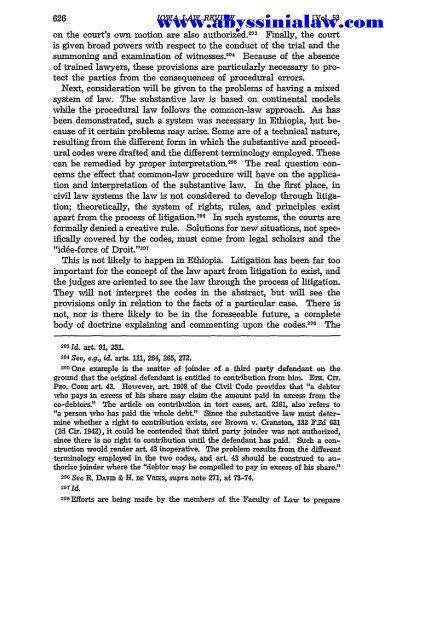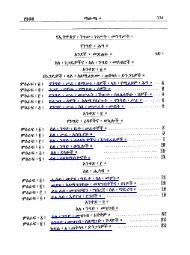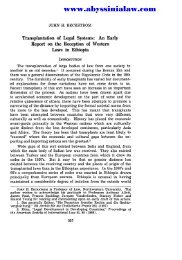Create successful ePaper yourself
Turn your PDF publications into a flip-book with our unique Google optimized e-Paper software.
IOWA LAW REVIEW<br />
on the court's own motion are also authorized. 293 Finally, the court<br />
is given broad powers with respect to the conduct of the trial and the<br />
summoning and examination of witnesses. 2 4 Because of the absence<br />
of trained lawyers, these provisions are particularly necessary to protect<br />
the parties from the consequences of procedural errors.<br />
Next, consideration will be given to the problems of having a mixed<br />
system of law. The substantive law is based on continental models<br />
while the procedural law follows the common-law approach. As has<br />
been demonstrated, such a system was necessary in Ethiopia, but because<br />
of it certain problems may arise. Some are of a technical nature,<br />
resulting from the different form in which the substantive and procedural<br />
codes were drafted and the different terminology employed. These<br />
can be remedied by proper interpretation. 295 The real question concerns<br />
the effect that common-law procedure will have on the application<br />
and interpretation of the substantive law. In the first place, in<br />
civil law systems the law is not considered to develop through litigation;<br />
theoretically, the system of rights, rules, and principles exist<br />
apart from the process of litigation. 29 In such systems, the courts are<br />
formally denied a creative rule. Solutions for new situations, not specifically<br />
covered by the codes, must come from legal scholars and the<br />
"id6e-force of Droit. '297<br />
This is not likely to happen in Ethiopia. Litigation has been far too<br />
important for the concept of the law apart from litigation to exist, and<br />
the judges are oriented to see the law through the process of litigation.<br />
They will not interpret the codes in the abstract, but will see the<br />
provisions only in relation to the facts of a particular case. There is<br />
not, nor is there likely to be in the foreseeable future, a complete<br />
body of doctrine explaining and commenting upon the codes. 298 [Vol 53<br />
www.abyssinialaw.com<br />
The<br />
9 Id. art. 91, 251.<br />
294 See, e.g., id. arts. 1M1, 264, 265, 272.<br />
^0 5 One example is the matter of joinder of a third party defendant on the<br />
ground that the original defendant is entitled to contribution from him. ETm Civ.<br />
PRo. CoDE art. 43. However, art. 1908 of the Civil Code provides that "a debtor<br />
who pays in excess of his share may claim the amount paid in excess from the<br />
co-debtors." The article on contribution in tort cases, art. 2161, also refers to<br />
"a person who has paid the whole debt." Since the substantive law must determine<br />
whether a right to contribution exists, see Brown v. Cranston, 132 F2d 631<br />
(2d Cir. 1942), it could be contended that third party joinder was not authorized,<br />
since there is no right to contribution until the defendant has paid. Such a construction<br />
would render art. 43 inoperative. The problem results from the different<br />
terminology employed in the two codes, and art. 43 should be construed to authorize<br />
joinder where the "debtor may be compelled to pay in excess of his share."<br />
206 See R. DAVm & H. DE Vmss, supra note 271, at 73-74.<br />
2971d.<br />
25B Efforts are being made by the members of the Faculty of <strong>Law</strong> to prepare





